General Introduction
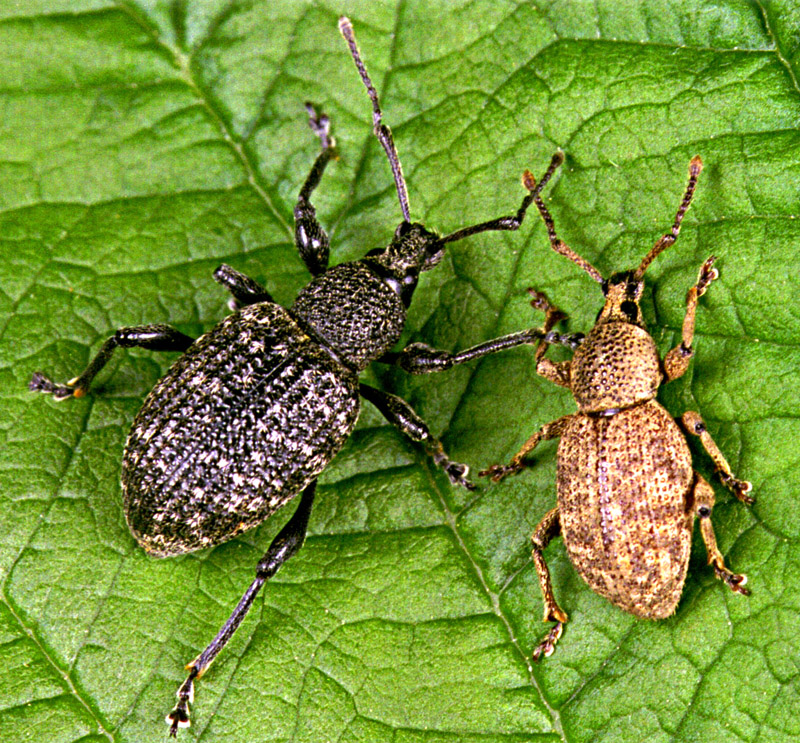 The important wingless weevils in the UK are members of the beetle group belonging to the genus Otiorhynchus. Within this genus at least three are important pests of soft fruit in the UK. They are the vine weevil (Otiorhynchus sulcatus), clay-coloured weevil (O. singularis) and the strawberry weevil (O. ovatus). The first two weevils are particularly important in northern Britain. There have been recent reports of exotic wingless weevils being found in several parts of the UK (Barclay MVL, The Coleopterist 12(2): 41-56, 2003). Otiorhynchus armadillo and O. salicicola are two European wingless weevils that have become established in Britain. One species, O. armadillo, is a known pest of raspberry in northern Italy and is a cause for concern. Fortunately, as yet, there are no reports of this weevil in commercial raspberry plantations in the UK. The image above shows adult vine weevil (Left) and clay-coloured weevil (Right). (Click on image to enlarge)
The important wingless weevils in the UK are members of the beetle group belonging to the genus Otiorhynchus. Within this genus at least three are important pests of soft fruit in the UK. They are the vine weevil (Otiorhynchus sulcatus), clay-coloured weevil (O. singularis) and the strawberry weevil (O. ovatus). The first two weevils are particularly important in northern Britain. There have been recent reports of exotic wingless weevils being found in several parts of the UK (Barclay MVL, The Coleopterist 12(2): 41-56, 2003). Otiorhynchus armadillo and O. salicicola are two European wingless weevils that have become established in Britain. One species, O. armadillo, is a known pest of raspberry in northern Italy and is a cause for concern. Fortunately, as yet, there are no reports of this weevil in commercial raspberry plantations in the UK. The image above shows adult vine weevil (Left) and clay-coloured weevil (Right). (Click on image to enlarge)
Vine Weevil
Introduction
 The vine weevil (Otiorhynchus sulcatus) is a known pest of raspberry in most temperate parts of the world. In Pacific North Western States of the USA, it is a major contaminant of machine harvested raspberry. In UK, they are an increasing problem in raspberry crops. Increasing vine weevil numbers over the past 30 years have been attributed to a reduction in the number of insecticides available for control and an increase in container potted plants and polythene mulches.
The vine weevil (Otiorhynchus sulcatus) is a known pest of raspberry in most temperate parts of the world. In Pacific North Western States of the USA, it is a major contaminant of machine harvested raspberry. In UK, they are an increasing problem in raspberry crops. Increasing vine weevil numbers over the past 30 years have been attributed to a reduction in the number of insecticides available for control and an increase in container potted plants and polythene mulches.
Image on left is an adult female vine weevil on raspberry leaf (click on image to enlarge)
Damage
Adult vine weevils have been reported to feed on more than 100 different plant species. The insects feed on leaves in a characteristic notching pattern. Larvae of the vine weevil attack plant root, which decreases plant development and production. Many plant species die when attacked by vine weevil larvae. In soft fruit, raspberry plants can tolerate moderate infestation whilst low numbers of larvae can kill young strawberry and blackcurrant plants. In raspberry, adult weevils shelter in the foliage during the day and can be dislodged during harvest resulting in contaminated crops.
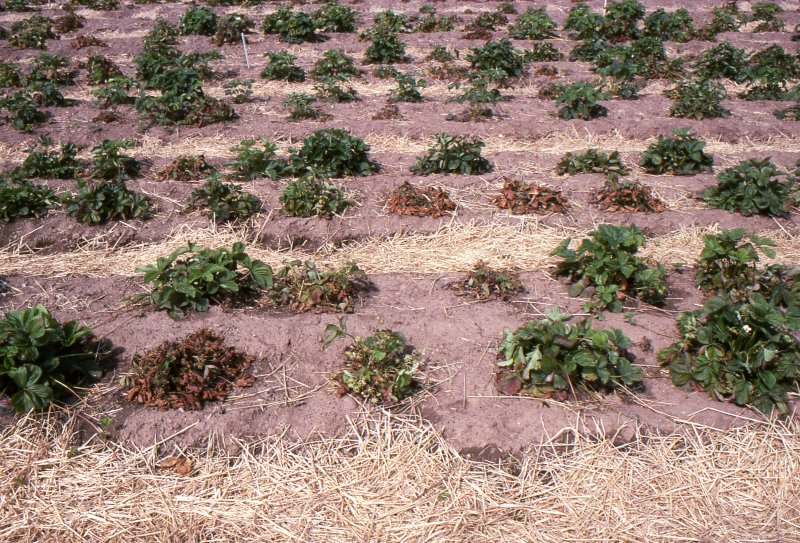 |
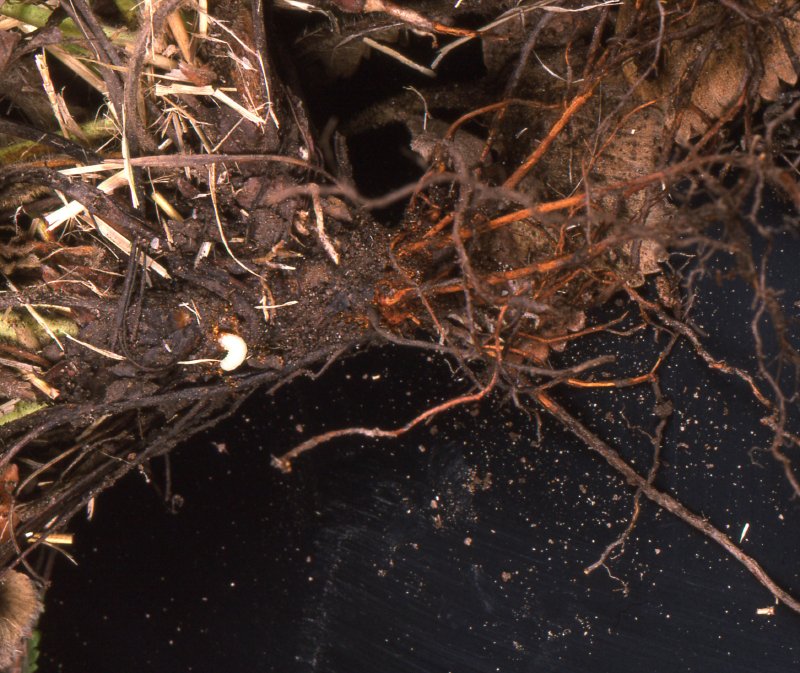 |
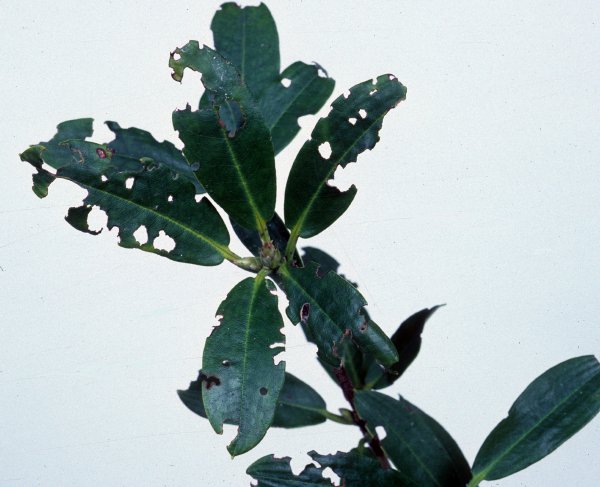 |
| Vine weevil damage to strawberry |
Damaged strawberry crown (vine weevil larvae exposed to right of picture centre) |
Adult feeding damage to Rhododendron |
Life Cycle
Vine weevils are parthenogenetic (only females, reproduction without males) and only reproduce once a year. Many adult weevils emerge in late spring and early summer, when a feeding frenzy commences before of egg-laying. Some adults emerging later in the year can survive overwinter given favourable conditions. Eggs laid on the plant or soil surface hatch after several days and the larvae burrow into the soil where they can feed on plant roots. After several developmental moults, the majority of weevils overwinter as larvae before pupating at the start of spring.
 |
 |
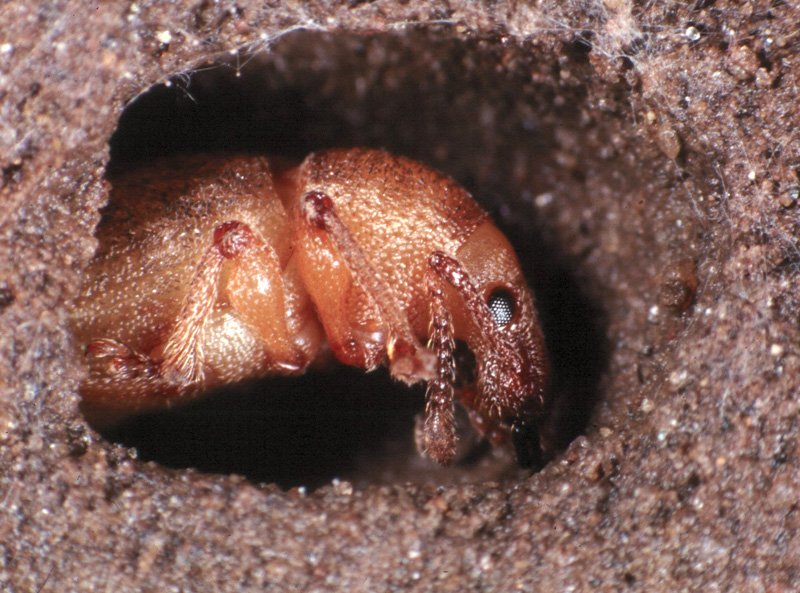 |
 |
|
Wingless weevil eggs - vine weevil eggs turn brown as they mature |
Group of vine weevil larvae showing range of sizes and typical 'C-shape' |
Teneral adult weevil in earthen pupal cell just prior to emergence |
Adult female vine weevil |
Control
Control of these insects has become more difficult with the withdrawal of many of the persistent organochlorine- based insecticides. Current insecticidal control in soft fruit is by application of sprays or drenches of a small number of products (consult your fruit advisor for up-to-date recommendations). Nematodes as a biocontrol method have been investigated, although they have been found to be ineffective in cooler climates. A suitable control method for vine weevils is currently being sought.
Clay-coloured Weevil
Introduction

The Clay-coloured weevil (Otiorhynchus singularis) (shown left) is locally important pests in raspberry plantations in east and central Scotland. Unlike the vine weevil, most damage to raspberry is caused by feeding of adult weevils in the spring. These weevils have a much narrower host range than vine weevil. They feed on hardy ornamental shrubs, most notably, rhododendrons and raspberry. These weevils have a similar geographic range to vine weevil and have recently been found feeding on raspberry in North-west USA. Also, like vine weevil, all the adults appear to be parthenogenic females. Click on image to enlarge
Damage
Raspberry: The most noticeable damage to raspberry is adult feeding to the buds and expanding fruiting laterals in the spring, and to newly planted canes. These animals feed after dark and have been observed on the cane when the air temperature was 4ºC. Most severe damage occurs when weevils emerge early in the season and feed on the expanding buds. If the secondary buds are also chewed, then yields can be severely affected. Later emergence results in a different form of damage. Adult weevils frequently chew the petioles of the expanding flower laterals. These subsequently break either in strong winds or by the increasing weight of the developing flowers and fruit. There is no evidence to show that larval feeding to the roots causes any noticeable loss of yield.
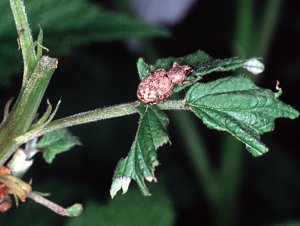 |
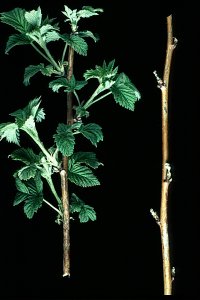 |
| Image of adult clay-coloured weevil feeding on raspberry fruiting lateral at night. Note damage to leaflets and to main lateral. | Severe damage to young fruiting laterals (right) caused by early attack by clay-coloured weevil in the spring. Cane on left not attacked. |
 Hardy Ornamental Nursery Plants: Adult feeding damage to perennial plants, such as rhododendron, is very similar to that caused by vine weevil and consequently much of the damage may be wrongly attributed. The most common symptom is notching on leaves, particularly those closer to the ground. There appears to be no significant damage caused by larval feeding.
Hardy Ornamental Nursery Plants: Adult feeding damage to perennial plants, such as rhododendron, is very similar to that caused by vine weevil and consequently much of the damage may be wrongly attributed. The most common symptom is notching on leaves, particularly those closer to the ground. There appears to be no significant damage caused by larval feeding.
Life Cycle
Laboratory studies at SCRI have shown that the adults have the potential to live for one or two years. Given an adequate food supply adult have several periods of egg laying in any one year. They have also the potential to lay in excess of 100 eggs per annum.
Clay-coloured weevil adults emerge in early spring. They climb up the plant after dark and feed on developing buds and flower shoots. They shelter in the soil and debris at the base of the plant. Eggs are laid in the soil and soon hatch. The larvae feed on the roots, often at the depth of about 50 cm. When fully mature, they pupate in earthen cells and emerge as adults.
 |
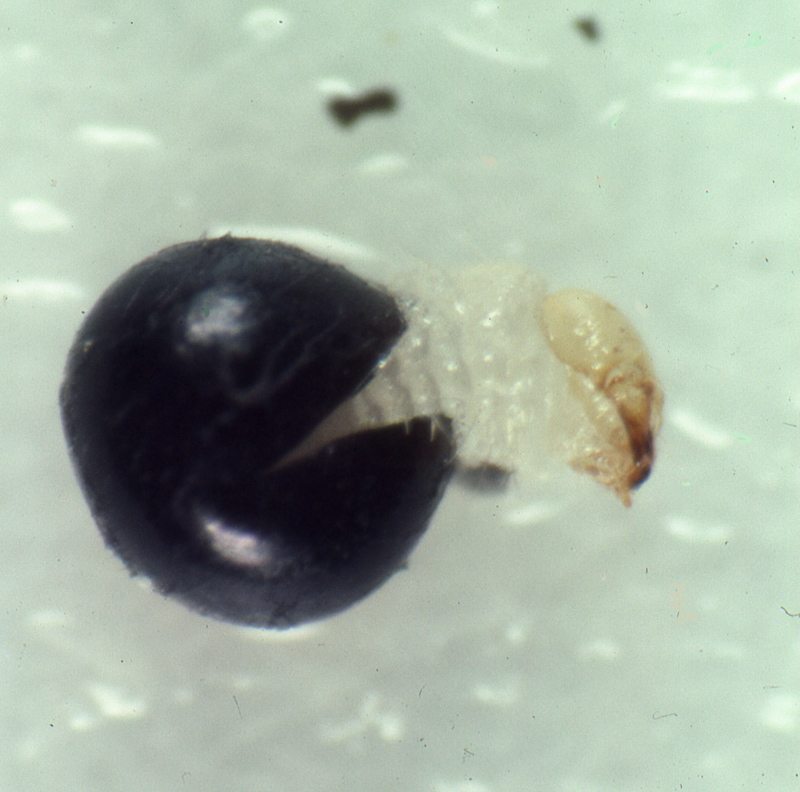 |
 |
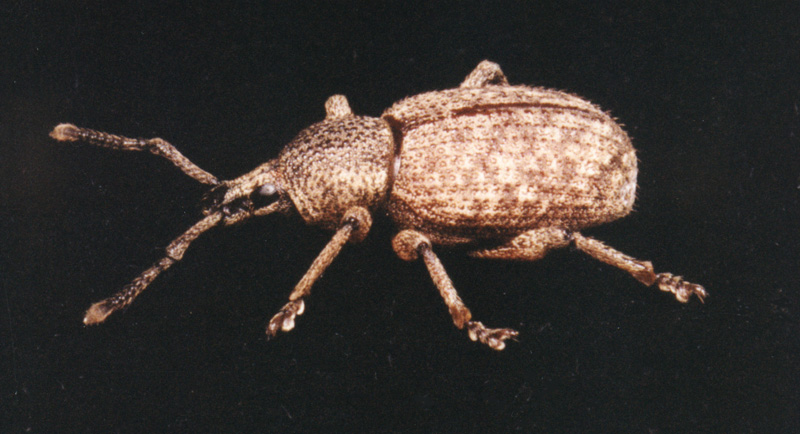 |
|
Clay-coloured weevil eggs |
Larvae emerging from egg |
Pupae in earthen cell |
Adult |
Control
The level of reported damage caused by clay-coloured weevil to raspberry started to increase about 10 years after the withdrawal of DDT in the 1970s. Since then several products have been used to manage adult numbers on the canes early in the spring (consult your fruit advisor for current recommendations). Although some have been successful at reducing the damage, the insect still remains a problem. The relative lack of success of insecticidal control has resulted in a reappraisal of this pest and new work to understand its behaviour has begun.
